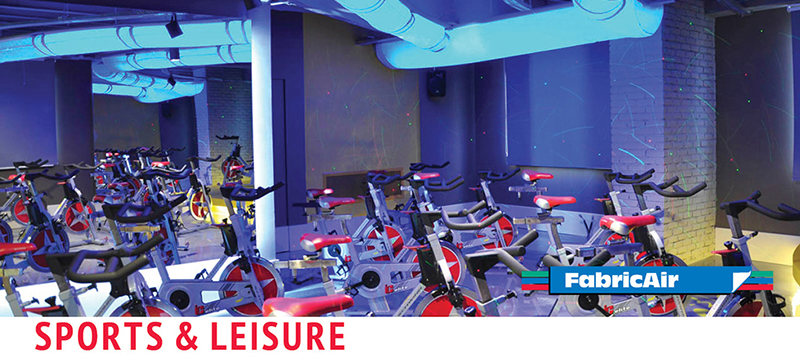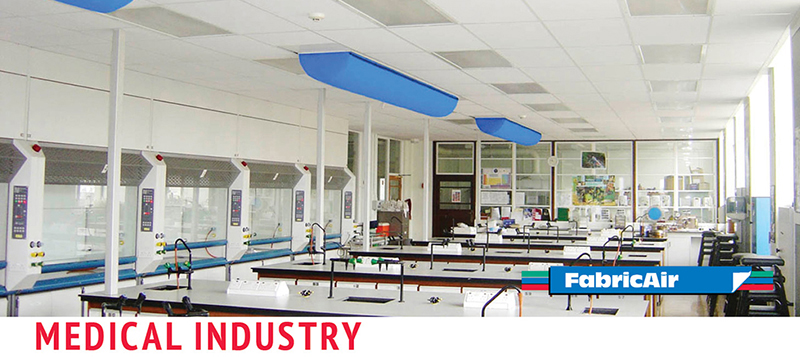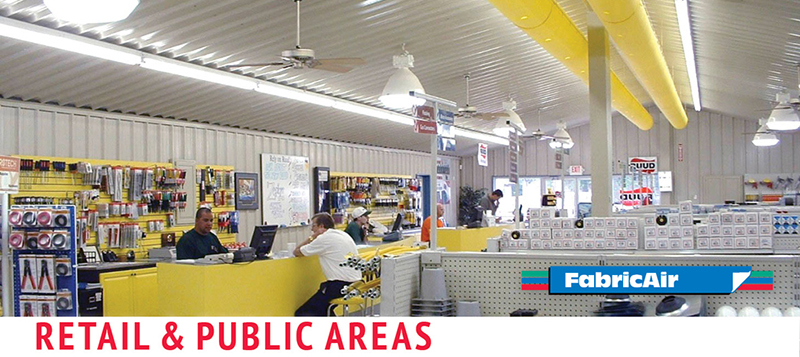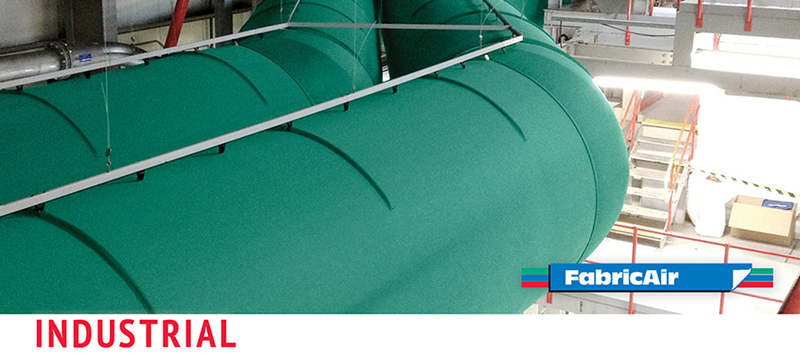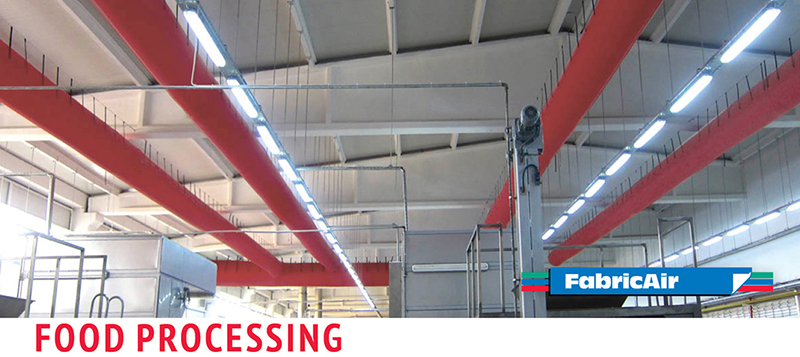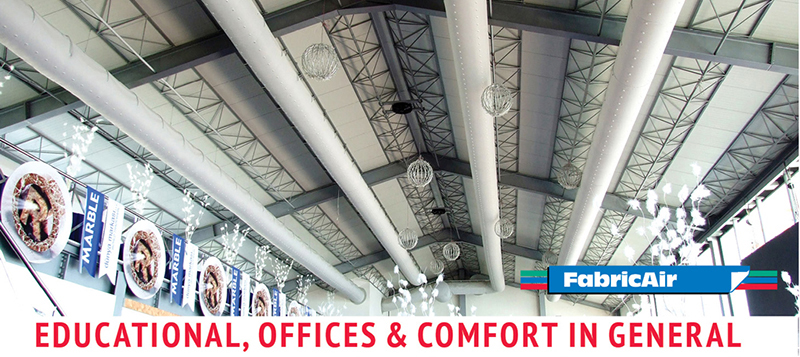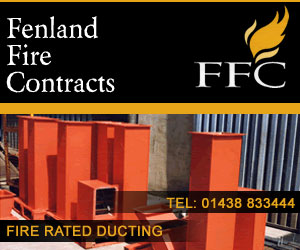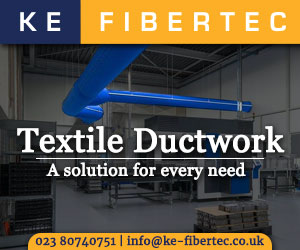Address
Unit 7 Genisis Park
Shefield Rd
Shefield Rd
Rotherham
South Yorkshire
S60 1DX
Opening Hours
Today
08:00-17:30
View All Hours
Sunday
Closed
Monday
08:00-17:30
Tuesday
08:00-17:30
Wednesday
08:00-17:30
Thursday
08:00-17:30
Friday
08:00-17:30
Saturday
08:00-17:30
About Fabricair Ltd
FabricAir – The Smart Way of Thinking Within HVAC/R
FabricAir designs and produces custom air dispersion & air distribution solutions for all applications.
We believe the future of HVAC/R is innovative air engineering technology. In 1973 we installed the world’s first textile channel system, which heralded a whole new way of thinking. We continue to be at the forefront of innovation and proudly deliver superior air dispersion to more than 94 countries.
A proven track record of more than 45 years is your guarantee for a superior air dispersion system. Experienced engineers ensure ideal airflow regardless of project complexity and due to efficient production methods and material selection your air dispersion system arrives on site in typically less than two weeks from order release.
Save up to 70%
Textile channels are an innovative alternative to metal ducting. Switching to FabricAir dispersion technology may save you up to 70% on total installed costs. The total savings on a project varies from 30% to 70% over the cost of conventional solutions.
Our engineers will help you design an efficient and cost-effective system that suits your needs. Please contact sales-uk@fabricair.com.
Why fabric?
Anywhere you can use exposed sheet metal ducting, you achieve advantages by switching to FabricAir ducting.
The versatility and flexibility is greater than conventional metal solutions. Complete freedom in design includes shapes, transitions, profiles and flow models; the technology does not require balancing and the need for dampers is minimal.
The technical properties are unrivalled:
Food processing facilities are kept incredibly clean despite the dirty activities that take place daily. The key is frequent wash-downs, including the air distribution system. FabricAir ducts are tailored in anti-microbial condensation resistant fabrics and can swiftly be taken down and washed.
Sports facilities are packed with people during events. This requires high ventilation rates and creates a significant risk of condensation on the ducts. Our technology delivers the right amount of air while maintaining comfort and eliminating condensation.
In industrial applications the duct is typically high off the ground, the structure is exposed, and large volumes of air are usually required. FabricAir ducts provide the required long throws, installation is easy and the cost savings are significant.
Retail & public areas are usually swarming with people and lit with spotlights and other heat sources causing significant changes in temperature and humidity throughout the day. FabricAir ducting enables even air distribution and efficient temperature response.
Education facilities, offices and other sedentary environments are common applications; ceiling heights are typically low; thus, it is critical to pay close attention to the elimination of drafts.
Medical applications require the highest level of cleanliness, whether it is a cleanroom or a laboratory. Textile channels are a great solution because of anti-microbial coating, launderability, no condensation or drafts, and cleanroom certified fabrics.
FabricAir designs and produces custom air dispersion & air distribution solutions for all applications.
We believe the future of HVAC/R is innovative air engineering technology. In 1973 we installed the world’s first textile channel system, which heralded a whole new way of thinking. We continue to be at the forefront of innovation and proudly deliver superior air dispersion to more than 94 countries.
A proven track record of more than 45 years is your guarantee for a superior air dispersion system. Experienced engineers ensure ideal airflow regardless of project complexity and due to efficient production methods and material selection your air dispersion system arrives on site in typically less than two weeks from order release.
Save up to 70%
Textile channels are an innovative alternative to metal ducting. Switching to FabricAir dispersion technology may save you up to 70% on total installed costs. The total savings on a project varies from 30% to 70% over the cost of conventional solutions.
Our engineers will help you design an efficient and cost-effective system that suits your needs. Please contact sales-uk@fabricair.com.
Why fabric?
- Flexibility of design makes it easy to modify and retrofit air dispersion systems
- Installation time savings provides lower installed cost vs. metal options
- Even air distribution across the conditioned space ensures greater occupant comfort & increased system efficiency
- All-in-One® suspension keeps the system inflated after shutdown for better aesthetics and system integrity
- A proven track record of 45 years across 94 countries and more than 6500 individual projects a year is your guarantee for unrivalled air dispersion
Anywhere you can use exposed sheet metal ducting, you achieve advantages by switching to FabricAir ducting.
The versatility and flexibility is greater than conventional metal solutions. Complete freedom in design includes shapes, transitions, profiles and flow models; the technology does not require balancing and the need for dampers is minimal.
The technical properties are unrivalled:
- No condensation problems
- Even air distribution
- Fireproof materials
- Excellent sound technical properties
- Hygienic and easy to maintain
Food processing facilities are kept incredibly clean despite the dirty activities that take place daily. The key is frequent wash-downs, including the air distribution system. FabricAir ducts are tailored in anti-microbial condensation resistant fabrics and can swiftly be taken down and washed.
Sports facilities are packed with people during events. This requires high ventilation rates and creates a significant risk of condensation on the ducts. Our technology delivers the right amount of air while maintaining comfort and eliminating condensation.
In industrial applications the duct is typically high off the ground, the structure is exposed, and large volumes of air are usually required. FabricAir ducts provide the required long throws, installation is easy and the cost savings are significant.
Retail & public areas are usually swarming with people and lit with spotlights and other heat sources causing significant changes in temperature and humidity throughout the day. FabricAir ducting enables even air distribution and efficient temperature response.
Education facilities, offices and other sedentary environments are common applications; ceiling heights are typically low; thus, it is critical to pay close attention to the elimination of drafts.
Medical applications require the highest level of cleanliness, whether it is a cleanroom or a laboratory. Textile channels are a great solution because of anti-microbial coating, launderability, no condensation or drafts, and cleanroom certified fabrics.
Fabricair Ltd.
5
out of 5
based on 6 ratings.
Reviews & Testimonials for Fabricair Ltd

“When we first contacted FabricAir and communicated our needs, they were most helpful and offered the best solutions for our production plant. We started using FabricAir dispersion systems in our plants five years ago. Ever since, we have managed to reach the desired cooling quality and witnessed a significant decrease in health problems and resulting paid leave.”
August 01, 2018
Testimonial by
Mehmet Sevim
Testimonial by
Mehmet Sevim

We are satisfied with the solution, as we can keep the predefined set values, even when the arena is full. At a recent event we had 4,700 spectators and we had no problems keeping the set values for temperature and CO2. The installation changes about 70,000 m3an hour and the fabric ducting works well.
April 03, 2018
Testimonial by
Hans Lundgaard
Testimonial by
Hans Lundgaard

This is the first time it has ever been cool at the top of the climbing wall.
March 03, 2015
Testimonial by
Gabriel Dagenais
Testimonial by
Gabriel Dagenais

During all project stages, FabricAir staff have worked very efficiently, provided professional advice, and proved that our management made the right choice when they decided to use FabricAir air dispersion systems
April 04, 2014
Testimonial by
Mr. Ramazan Evir
Testimonial by
Mr. Ramazan Evir

We were supplied with spare ducts which means that we can quite simply remove ducts when they need cleaning, send them to the laundry, and use the substitute ducts until the original ones return. Members enjoy the pleasant feeling of standing in front of the mirrors to cool off as the air circulates around them.
May 05, 2012
Testimonial by
Mike Holt
Testimonial by
Mike Holt

We were impressed to see the reference lists and the work FabricAir has done. The technical engineers also influenced our approach to technical problems and technical experience. We will continue to favor FabricAir solutions for future investments.
November 14, 2011
Testimonial by
İlhan Bey
Testimonial by
İlhan Bey
Gallery
Videos
News
Restaurants have a unique set of ventilation ducting requirements that all have significant impact on the user experience. Selecting a solution with good acoustic values, hygienic properties and aesthetics is essential to meet both the design scheme and create optimum occupant comfort.
Maximising occupant comfort is key to success in the restaurant business – in addition to great food of course. Comfortable patrons means repeat business. The company is good, the food is delicious and perhaps there's even a glass of wine; smiles, laughter and enjoyable conversation all around. It sounds cozy – and with the right ventilation ducting it certainly also can be.
The specific requirements include comfort elements such as an even draft-free air distribution, sound absorption and reverberation as well as aesthetics. In addition, hygienic elements such as condensation-free, dirt repellant and washable are essential, and enabling easy maintenance as well as fulfilling cost-efficiency considerations is ideal. Fabric ducting is the only alternative that allows all these different measures to be satisfied.
Restaurants, diners, cafes and similar applications all struggle with sound generation as well as reverberation. A bad acoustic environment makes it less of a pleasant experience; hence, the sound absorption properties of the room is an important design consideration. Reducing reverberation time is important for speech intelligibility and conversational privacy, and also helps reduce the overall noise levels.
Fabric-based ventilation ducting offers a LowNoise™ technology, which enables noise levels as low as NC15 or less. The precise air dispersion creates a high air change at low velocity, which makes the solution draft-free and virtually silent. This coupled with the acoustic absorption capabilities of the fabric and the unlimited design possibilities makes the technology preferred among hospitality designers.
"We recommend FabricAir Dispersion systems because of the efficiency and because it offers unique design opportunities. There are no hot spots and cold spots, there is no condensation dripping like with metal ducts, and it comes in a swoon of colours," said PJ Zakas of Z-Space Design, a cutting-edge US Hospitality Design company. "Things do get dirty, especially in restaurants, so we love to explain to our clients that you can easily unzip that bad boy, take it home, put it in your wash, dry it and throw it back up – you can't do that with metal!"
Z-Space Design are the architects behind the recently opened, South Carolina-based Jî-Rôz - an upscale Greek restaurant. They used tan beige FabricAir ducts as a design feature that accents the overall design theme of the exclusive restaurant space.
The fabric air dispersion technology is also the more hygienic alternative. Permeable fabrics create an air blanket around the entire length and circumference of the duct. This prevents condensation and hinders dust and other particles from settling on top of the ducts. The anti-microbial nature of the ducting thwarts bacteria growth.
Micro-perforations can make the ducting virtually maintenance-free and should it happen that the ductwork gets dirty, it's easy to slide the ducting off the suspension, wash it in in a regular washing machine and hang it back up.
In Zaragoza, Spain, El Cachirulo Group, who owns a number of exclusive restaurants, has applied FabricAir Dispersion Systems in several locations. Sansui is a popular event and convention venue with great historical tradition. When the salon was upgraded, fabric-based air dispersion was used to ensure a fusion of optimum comfort and aesthetic looks. When another of their high-end venues, the Palacio de Larrinaga, underwent refurbishments, space saving was essential to the project, in addition to creating a draft-free, noiseless air dispersion for maximum comfort.
"Our customers are quality conscious; we must minimise the air currents and the sound level, always maintaining the right temperature. Last year we installed FabricAir solutions in other facilities within our group and they work very well. In this space, we wanted to integrate elegant design and optimum comfort. In the summer months, temperatures are high in Zaragoza and the air conditioning has worked well - we have not had any complaints," said Technical Manager of Maintenance, Luis Catalan, Grupo El Cachirulo.
In Izmir, Turkey, a corrosion-free, lightweight and stylish solution was needed in a dining and concert venue, the Izmir Arena, located close to the sea. It was essential to minimise the strain on the existing roof structure, as well as to prevent negative impacts on the acoustics of the room.
"FabricAir designed the perfect flow models for our place. Since we started using our air distribution system, we have had no problems. We feel that the FabricAir products increase the air comfort of the place, and blend beautifully into the structure," added Hasan KARABI
Maximising occupant comfort is key to success in the restaurant business – in addition to great food of course. Comfortable patrons means repeat business. The company is good, the food is delicious and perhaps there's even a glass of wine; smiles, laughter and enjoyable conversation all around. It sounds cozy – and with the right ventilation ducting it certainly also can be.
The specific requirements include comfort elements such as an even draft-free air distribution, sound absorption and reverberation as well as aesthetics. In addition, hygienic elements such as condensation-free, dirt repellant and washable are essential, and enabling easy maintenance as well as fulfilling cost-efficiency considerations is ideal. Fabric ducting is the only alternative that allows all these different measures to be satisfied.
Restaurants, diners, cafes and similar applications all struggle with sound generation as well as reverberation. A bad acoustic environment makes it less of a pleasant experience; hence, the sound absorption properties of the room is an important design consideration. Reducing reverberation time is important for speech intelligibility and conversational privacy, and also helps reduce the overall noise levels.
Fabric-based ventilation ducting offers a LowNoise™ technology, which enables noise levels as low as NC15 or less. The precise air dispersion creates a high air change at low velocity, which makes the solution draft-free and virtually silent. This coupled with the acoustic absorption capabilities of the fabric and the unlimited design possibilities makes the technology preferred among hospitality designers.
"We recommend FabricAir Dispersion systems because of the efficiency and because it offers unique design opportunities. There are no hot spots and cold spots, there is no condensation dripping like with metal ducts, and it comes in a swoon of colours," said PJ Zakas of Z-Space Design, a cutting-edge US Hospitality Design company. "Things do get dirty, especially in restaurants, so we love to explain to our clients that you can easily unzip that bad boy, take it home, put it in your wash, dry it and throw it back up – you can't do that with metal!"
Z-Space Design are the architects behind the recently opened, South Carolina-based Jî-Rôz - an upscale Greek restaurant. They used tan beige FabricAir ducts as a design feature that accents the overall design theme of the exclusive restaurant space.
The fabric air dispersion technology is also the more hygienic alternative. Permeable fabrics create an air blanket around the entire length and circumference of the duct. This prevents condensation and hinders dust and other particles from settling on top of the ducts. The anti-microbial nature of the ducting thwarts bacteria growth.
Micro-perforations can make the ducting virtually maintenance-free and should it happen that the ductwork gets dirty, it's easy to slide the ducting off the suspension, wash it in in a regular washing machine and hang it back up.
In Zaragoza, Spain, El Cachirulo Group, who owns a number of exclusive restaurants, has applied FabricAir Dispersion Systems in several locations. Sansui is a popular event and convention venue with great historical tradition. When the salon was upgraded, fabric-based air dispersion was used to ensure a fusion of optimum comfort and aesthetic looks. When another of their high-end venues, the Palacio de Larrinaga, underwent refurbishments, space saving was essential to the project, in addition to creating a draft-free, noiseless air dispersion for maximum comfort.
"Our customers are quality conscious; we must minimise the air currents and the sound level, always maintaining the right temperature. Last year we installed FabricAir solutions in other facilities within our group and they work very well. In this space, we wanted to integrate elegant design and optimum comfort. In the summer months, temperatures are high in Zaragoza and the air conditioning has worked well - we have not had any complaints," said Technical Manager of Maintenance, Luis Catalan, Grupo El Cachirulo.
In Izmir, Turkey, a corrosion-free, lightweight and stylish solution was needed in a dining and concert venue, the Izmir Arena, located close to the sea. It was essential to minimise the strain on the existing roof structure, as well as to prevent negative impacts on the acoustics of the room.
"FabricAir designed the perfect flow models for our place. Since we started using our air distribution system, we have had no problems. We feel that the FabricAir products increase the air comfort of the place, and blend beautifully into the structure," added Hasan KARABI
Traditional ventilation systems generate noise as the air passes through the ducting and into plenum boxes and out through spot diffusers. Fabric-based air dispersion solutions create minimal resistance, thus no significant sound – as low as NC 15.
Noise level considerations differ vastly from application to application. Libraries, theaters, auditoriums, concert halls, recording studios and religious facilities are examples of applications that require very low levels of noise; hence, minimising noise transmissions and controlling sound characteristic within the space are crucial.
Conventional ventilation solutions in metal are rigid and therefore transmit noise. Structural vibrations manifests themselves in the metal, sounds reverberate off the surface, and the airstream generates noise as it travels through the system. The classic ducts may also transport sounds like speech directly from spot diffusers in one room to spot diffusers in adjacent rooms, e.g. in an office structure.
In comfort applications the acoustic properties of fabric ducting are highly relevant. Sound absorption reduces reverberation time, which increases conversation privacy, makes speech more intelligible and can help reduce the general noise level in the space. This leads to a greater level of occupant comfort. The virtually silent nature of the technology means that the fabric duct system doesn't transmit noise.
FabricAir systems typically operate in the 25-30 NC level range, but can be designed to go as low as NC 15. This makes the technology ideal in comfort applications, as the ventilation system then does not contribute negative noise pollution to the space being conditioned. This is why fabric-based air dispersion solutions are the popular choice for theaters, concert halls, schools, and so forth.
The Lila Cockrell Theater in San Antonio, Texas was upgraded to ensure a healthy work environment for the performers as well as a comfortable experience for the audience. Mike Duarte, from the project team, explains why FabricAir dispersion was the ideal solution for this project. "The stage area presented a specific set of requirements with respect to noise and drafts. We needed to dissipate a lot of heat without causing drafts and movement in the curtains. Using displacement-based air diffusion in the stage area ensured draft-free cooling with NC levels lower than 15. We enabled a high air change with low velocity that created the perfect on stage environment for the performers."
The old metal-based air dispersion system was not circulating enough air to the audience and was an eyesore to the architecture. The team worked with the local architect to create a design that would allow the air conditioning ducts to blend in rather than stand out. "Noise and draft restrictions were also relevant in the seating area, which meant designing a solution that would enable a high air change at low velocity while being quiet and unobtrusive to the space," explains Mike Duarte.
When the newly build facilities of the Danish Broadcasting Company, DR Byen in Copenhagen, Denmark, was facing problems with an inadequate conventional air dispersion solution, they also turned to fabric-based technology. This was a project with very specific requirements in terms of noise (max NC15), air velocity (0,13m/s) and space restrictions, in addition to condensation issues caused by a large ?T. It was solved using underfloor fabric ducting to deliver the necessary airflow without causing disturbing noise pollution from sound transmission and reverberating. The condensation challenge was solved using a permeable fabric type. It also meant insulation was not needed, making the solution highly space-efficient.
In applications like theaters, auditoriums and concert halls, conventional solutions often fall short, as they require large orifices to generate a high air change. This results in unpleasant, even unhealthy drafts, as well as transmission and reverberation of noise. The same is true for silent applications such as libraries and religious facilities. Fabric-based air dispersion technology is draft-free and virtually silent, thus offers the ideal environment in these application types. They provide a high air change with great levels of comfort.
Noise level considerations differ vastly from application to application. Libraries, theaters, auditoriums, concert halls, recording studios and religious facilities are examples of applications that require very low levels of noise; hence, minimising noise transmissions and controlling sound characteristic within the space are crucial.
Conventional ventilation solutions in metal are rigid and therefore transmit noise. Structural vibrations manifests themselves in the metal, sounds reverberate off the surface, and the airstream generates noise as it travels through the system. The classic ducts may also transport sounds like speech directly from spot diffusers in one room to spot diffusers in adjacent rooms, e.g. in an office structure.
In comfort applications the acoustic properties of fabric ducting are highly relevant. Sound absorption reduces reverberation time, which increases conversation privacy, makes speech more intelligible and can help reduce the general noise level in the space. This leads to a greater level of occupant comfort. The virtually silent nature of the technology means that the fabric duct system doesn't transmit noise.
FabricAir systems typically operate in the 25-30 NC level range, but can be designed to go as low as NC 15. This makes the technology ideal in comfort applications, as the ventilation system then does not contribute negative noise pollution to the space being conditioned. This is why fabric-based air dispersion solutions are the popular choice for theaters, concert halls, schools, and so forth.
The Lila Cockrell Theater in San Antonio, Texas was upgraded to ensure a healthy work environment for the performers as well as a comfortable experience for the audience. Mike Duarte, from the project team, explains why FabricAir dispersion was the ideal solution for this project. "The stage area presented a specific set of requirements with respect to noise and drafts. We needed to dissipate a lot of heat without causing drafts and movement in the curtains. Using displacement-based air diffusion in the stage area ensured draft-free cooling with NC levels lower than 15. We enabled a high air change with low velocity that created the perfect on stage environment for the performers."
The old metal-based air dispersion system was not circulating enough air to the audience and was an eyesore to the architecture. The team worked with the local architect to create a design that would allow the air conditioning ducts to blend in rather than stand out. "Noise and draft restrictions were also relevant in the seating area, which meant designing a solution that would enable a high air change at low velocity while being quiet and unobtrusive to the space," explains Mike Duarte.
When the newly build facilities of the Danish Broadcasting Company, DR Byen in Copenhagen, Denmark, was facing problems with an inadequate conventional air dispersion solution, they also turned to fabric-based technology. This was a project with very specific requirements in terms of noise (max NC15), air velocity (0,13m/s) and space restrictions, in addition to condensation issues caused by a large ?T. It was solved using underfloor fabric ducting to deliver the necessary airflow without causing disturbing noise pollution from sound transmission and reverberating. The condensation challenge was solved using a permeable fabric type. It also meant insulation was not needed, making the solution highly space-efficient.
In applications like theaters, auditoriums and concert halls, conventional solutions often fall short, as they require large orifices to generate a high air change. This results in unpleasant, even unhealthy drafts, as well as transmission and reverberation of noise. The same is true for silent applications such as libraries and religious facilities. Fabric-based air dispersion technology is draft-free and virtually silent, thus offers the ideal environment in these application types. They provide a high air change with great levels of comfort.
Fabric ducting differs from metal solutions in that they have acoustic absorption properties and do not transmit sound. This is important, as it reduces sound reverberation, by hindering the sound reflecting back into the space from the duct surface.
The acoustic environment is influenced by many factors including the geometry and volume of the space; transmission, reflection and sound absorption capabilities of the materials used and surfaces inside and surrounding the space; and airborne and structure-borne sound transmission. Unwanted sounds and noise pollution can have a negative impact on health and wellbeing of the occupants, as well as on their communication and productivity. This is why minimising the noise contribution from the ventilation solution is important.
Acoustic design includes control of sound transmission as well as sound absorption. The ventilation solution is just one factor, but when properly designed fabric ducts can be a positive acoustic element as well as provide a pleasant indoor climate in terms of draft-free, virtually silent air dispersion.
The fabric fibers are a so-called porous absorbent that absorbs the sounds by turning sound waves into heat energy. This happens as the fibers are forced to bend by the sound waves. In comfort applications the acoustic properties of fabric ducting are thus highly relevant. Sound absorption reduces reverberation time, which increases conversation privacy, makes speech more intelligible and can help reduce the general noise level in the space. This leads to a greater level of occupant comfort. The virtually silent nature of the technology means that the fabric duct system doesn’t transmit noise.
The acoustic environment is influenced by many factors including the geometry and volume of the space; transmission, reflection and sound absorption capabilities of the materials used and surfaces inside and surrounding the space; and airborne and structure-borne sound transmission. Unwanted sounds and noise pollution can have a negative impact on health and wellbeing of the occupants, as well as on their communication and productivity. This is why minimising the noise contribution from the ventilation solution is important.
Acoustic design includes control of sound transmission as well as sound absorption. The ventilation solution is just one factor, but when properly designed fabric ducts can be a positive acoustic element as well as provide a pleasant indoor climate in terms of draft-free, virtually silent air dispersion.
The fabric fibers are a so-called porous absorbent that absorbs the sounds by turning sound waves into heat energy. This happens as the fibers are forced to bend by the sound waves. In comfort applications the acoustic properties of fabric ducting are thus highly relevant. Sound absorption reduces reverberation time, which increases conversation privacy, makes speech more intelligible and can help reduce the general noise level in the space. This leads to a greater level of occupant comfort. The virtually silent nature of the technology means that the fabric duct system doesn’t transmit noise.
Traditional ventilation systems generate noise as the air passes through the ducting and into plenum boxes and out through spot diffusers. Fabric-based air dispersion solutions create minimal resistance, thus no significant sound – as low as NC 15.
Noise level considerations differ vastly from application to application. Libraries, theatres, auditoriums, concert halls, recording studios and religious facilities are examples of applications that require very low levels of noise; hence, minimising noise transmissions and controlling sound characteristic within the space are crucial.
Conventional ventilation solutions in metal are rigid and therefore transmit noise. Structural vibrations manifest themselves in the metal, sounds reverberate off the surface, and the air stream generates noise as it travels through the system. The classic ducts may also transport sounds like speech directly from spot diffusers in one room to spot diffusers in adjacent rooms.
In comfort applications the acoustic properties of fabric ducting are highly relevant. Sound absorption reduces reverberation time, which increases conversation privacy, makes speech more intelligible and can help reduce the general noise level in the space. This leads to a greater level of occupant comfort. The virtually silent nature of the technology means that the fabric duct system doesn't transmit noise.
FabricAir systems typically operate in the 25-30 NC level range, but can be designed to go as low as NC 15. This makes the technology ideal in comfort applications, as the ventilation system then does not contribute negative noise pollution to the space being conditioned. This is why fabric-based air dispersion solutions are the popular choice for theatres, concert halls, schools, and so forth.
The Lila Cockrell Theater in San Antonio, Texas was upgraded to ensure a healthy work environment for the performers as well as a comfortable experience for the audience. Mike Duarte, from the project team, explains why FabricAir dispersion was the ideal solution for this project. "The stage area presented a specific set of requirements with respect to noise and drafts. We needed to dissipate a lot of heat without causing drafts and movement in the curtains. Using displacement-based air diffusion in the stage area ensured draft-free cooling with NC levels lower than 15. We enabled a high air change with low velocity that created the perfect on stage environment for the performers."
?The old metal-based air dispersion system was not circulating enough air to the audience and was an eyesore to the architecture. The team worked with the local architect to create a design that would allow the air conditioning ducts to blend in rather than stand out.
"Noise and draft restrictions were also relevant in the seating area, which meant designing a solution that would enable a high air change at low velocity while being quiet and unobtrusive to the space," he added.
When the newly built facilities of the Danish Broadcasting Company, DR Byen in Copenhagen, Denmark, were facing problems with an inadequate conventional air dispersion solution, they also turned to fabric-based technology. This was a project with very specific requirements in terms of noise (max NC15), air velocity (0,13m/s) and space restrictions, in addition to condensation issues caused by a large ?T. It was solved using underfloor fabric ducting to deliver the necessary airflow without causing disturbing noise pollution from sound transmission and reverberating. The condensation challenge was solved using a permeable fabric type. It also meant insulation was not needed, making the solution highly space-efficient.
In applications like theatres, auditoriums and concert halls, conventional solutions often fall short, as they require large orifices to generate a high air change. This results in unpleasant, even unhealthy drafts, as well as transmission and reverberation of noise. The same is true for silent applications such as libraries and religious facilities. Fabric-based air dispersion technology is draft-free and virtually silent, thus offers the ideal environment in these application types. They provide a high air change with great levels of comfort.
Noise level considerations differ vastly from application to application. Libraries, theatres, auditoriums, concert halls, recording studios and religious facilities are examples of applications that require very low levels of noise; hence, minimising noise transmissions and controlling sound characteristic within the space are crucial.
Conventional ventilation solutions in metal are rigid and therefore transmit noise. Structural vibrations manifest themselves in the metal, sounds reverberate off the surface, and the air stream generates noise as it travels through the system. The classic ducts may also transport sounds like speech directly from spot diffusers in one room to spot diffusers in adjacent rooms.
In comfort applications the acoustic properties of fabric ducting are highly relevant. Sound absorption reduces reverberation time, which increases conversation privacy, makes speech more intelligible and can help reduce the general noise level in the space. This leads to a greater level of occupant comfort. The virtually silent nature of the technology means that the fabric duct system doesn't transmit noise.
FabricAir systems typically operate in the 25-30 NC level range, but can be designed to go as low as NC 15. This makes the technology ideal in comfort applications, as the ventilation system then does not contribute negative noise pollution to the space being conditioned. This is why fabric-based air dispersion solutions are the popular choice for theatres, concert halls, schools, and so forth.
The Lila Cockrell Theater in San Antonio, Texas was upgraded to ensure a healthy work environment for the performers as well as a comfortable experience for the audience. Mike Duarte, from the project team, explains why FabricAir dispersion was the ideal solution for this project. "The stage area presented a specific set of requirements with respect to noise and drafts. We needed to dissipate a lot of heat without causing drafts and movement in the curtains. Using displacement-based air diffusion in the stage area ensured draft-free cooling with NC levels lower than 15. We enabled a high air change with low velocity that created the perfect on stage environment for the performers."
?The old metal-based air dispersion system was not circulating enough air to the audience and was an eyesore to the architecture. The team worked with the local architect to create a design that would allow the air conditioning ducts to blend in rather than stand out.
"Noise and draft restrictions were also relevant in the seating area, which meant designing a solution that would enable a high air change at low velocity while being quiet and unobtrusive to the space," he added.
When the newly built facilities of the Danish Broadcasting Company, DR Byen in Copenhagen, Denmark, were facing problems with an inadequate conventional air dispersion solution, they also turned to fabric-based technology. This was a project with very specific requirements in terms of noise (max NC15), air velocity (0,13m/s) and space restrictions, in addition to condensation issues caused by a large ?T. It was solved using underfloor fabric ducting to deliver the necessary airflow without causing disturbing noise pollution from sound transmission and reverberating. The condensation challenge was solved using a permeable fabric type. It also meant insulation was not needed, making the solution highly space-efficient.
In applications like theatres, auditoriums and concert halls, conventional solutions often fall short, as they require large orifices to generate a high air change. This results in unpleasant, even unhealthy drafts, as well as transmission and reverberation of noise. The same is true for silent applications such as libraries and religious facilities. Fabric-based air dispersion technology is draft-free and virtually silent, thus offers the ideal environment in these application types. They provide a high air change with great levels of comfort.
FabricAir Dispersion Systems have a lower carbon footprint than conventional metal ducting. They enable operational energy savings of up to 40%.
Ventilation systems in fabric require less energy to produce and transport. At the same time, the efficiency of the air distribution is much higher and more precise with textile-based ventilation than with conventional metal ducting. This means that ventilation solutions from FabricAir operate with a lower pressure loss and therefore require less energy to operate. The lower pressure loss can save up to 40% on the power bill.
Environmentally friendly production
FabricAir's textiles meet the OEKO-TEX 100 requirements, which confirm that we commit to environmentally friendly production methods and materials. The expected lifetime of a fabric duct is long; several of the original installations from the 70s are still being used in slaughterhouses around Denmark.
Due to the compact nature of the ducts, they take up significantly less space than metal ducts during transport. In fact, calculations show that FabricAir Dispersion systems emit 21.3% less CO2 from transport than corresponding ducts in metal.
Creating the ideal indoor air quality
Using FabricAir dispersion technology offers a number of additional advantages including even, draft-free air dispersion and no condensation issues, which creates the ideal indoor environment. The fabrics do not corrode, which makes this technology especially advantageous in swimming pools and other highly corrosive environments. Using flow models and permeable fabrics prevents dust and other particles from settling inside and onto the duct, rendering the ducts technically maintenance-free; should there be a need for cleaning, the easy suspension methods ensure quick dismantling and re-installation, and the ducts can simply be washed in a washing machine.
The added bonus of a sustainable ventilation system with a low carbon footprint is the significant savings of up to 70% on total installed costs.
Ventilation systems in fabric require less energy to produce and transport. At the same time, the efficiency of the air distribution is much higher and more precise with textile-based ventilation than with conventional metal ducting. This means that ventilation solutions from FabricAir operate with a lower pressure loss and therefore require less energy to operate. The lower pressure loss can save up to 40% on the power bill.
Environmentally friendly production
FabricAir's textiles meet the OEKO-TEX 100 requirements, which confirm that we commit to environmentally friendly production methods and materials. The expected lifetime of a fabric duct is long; several of the original installations from the 70s are still being used in slaughterhouses around Denmark.
Due to the compact nature of the ducts, they take up significantly less space than metal ducts during transport. In fact, calculations show that FabricAir Dispersion systems emit 21.3% less CO2 from transport than corresponding ducts in metal.
Creating the ideal indoor air quality
Using FabricAir dispersion technology offers a number of additional advantages including even, draft-free air dispersion and no condensation issues, which creates the ideal indoor environment. The fabrics do not corrode, which makes this technology especially advantageous in swimming pools and other highly corrosive environments. Using flow models and permeable fabrics prevents dust and other particles from settling inside and onto the duct, rendering the ducts technically maintenance-free; should there be a need for cleaning, the easy suspension methods ensure quick dismantling and re-installation, and the ducts can simply be washed in a washing machine.
The added bonus of a sustainable ventilation system with a low carbon footprint is the significant savings of up to 70% on total installed costs.
Fabric ducting differs from metal solutions in that they have acoustic absorption properties and do not transmit sound. This is important, as it reduces sound reverberation, by hindering the sound reflecting back into the space from the duct surface.
The acoustic environment is influenced by many factors including the geometry and volume of the space; transmission, reflection and sound absorption capabilities of the materials used and surfaces inside and surrounding the space; and airborne and structure-borne sound transmission. Unwanted sounds and noise pollution can have a negative impact on health and wellbeing of the occupants, as well as on their communication and productivity. This is why minimising the noise contribution from the ventilation solution is important.
Acoustic design includes control of sound transmission as well as sound absorption. The ventilation solution is just one factor, but when properly designed fabric ducts can be a positive acoustic element as well as provide a pleasant indoor climate in terms of draft-free, virtually silent air dispersion.
The fabric fibers are a so-called porous absorbent that absorbs the sounds by turning sound waves into heat energy. This happens as the fibers are forced to bend by the sound waves. In comfort applications the acoustic properties of fabric ducting are thus highly relevant. Sound absorption reduces reverberation time, which increases conversation privacy, makes speech more intelligible and can help reduce the general noise level in the space. This leads to a greater level of occupant comfort. The virtually silent nature of the technology means that the fabric duct system doesn't transmit noise.
The acoustic environment is influenced by many factors including the geometry and volume of the space; transmission, reflection and sound absorption capabilities of the materials used and surfaces inside and surrounding the space; and airborne and structure-borne sound transmission. Unwanted sounds and noise pollution can have a negative impact on health and wellbeing of the occupants, as well as on their communication and productivity. This is why minimising the noise contribution from the ventilation solution is important.
Acoustic design includes control of sound transmission as well as sound absorption. The ventilation solution is just one factor, but when properly designed fabric ducts can be a positive acoustic element as well as provide a pleasant indoor climate in terms of draft-free, virtually silent air dispersion.
The fabric fibers are a so-called porous absorbent that absorbs the sounds by turning sound waves into heat energy. This happens as the fibers are forced to bend by the sound waves. In comfort applications the acoustic properties of fabric ducting are thus highly relevant. Sound absorption reduces reverberation time, which increases conversation privacy, makes speech more intelligible and can help reduce the general noise level in the space. This leads to a greater level of occupant comfort. The virtually silent nature of the technology means that the fabric duct system doesn't transmit noise.
In the 45 years since the first introduction of fabric-based air dispersion technology the concept has been developed and refined, but the primary differences between fabric and metal-based HVAC/R solutions are still founded on comfort, hygiene, efficiency and savings.
Conventional metal ducting uses spot diffusion, which creates stagnant air zones, unpleasant drafts and inconvenient noise pollution. From a comfort perspective this is the primary difference between metal solutions and FabricAir dispersion technology.
From a hygienic perspective, the condensation-free nature of fabric ducts diminishes the risk of microbial growth inside or on the ducting. Specific fabrics even have Cleanroom 3 certification. The fabrics are created in woven polyester fibers, which ensures that the ducts can be washed, even sterilized in an autoclave, without causing negative impact on their performance.
The initial advantage of fabric air dispersion technology was twofold: Eliminating drafts created a more healthy work environment, thus lowering the number of absences; and creating better airflow patterns resulted in a more even air distribution and lower temperature gradients in the meat processing plants where the technology was first applied. The latter has been an area of thorough research, which had led to a wide array of flow models that can be combined to optimize induction in any given project. This is part of what makes the technology more efficient than conventional metal solutions.
Surface flow models enable high air changes at low velocity, which is good for low ceiling applications and comfort. Directional flow models enable precise longer throws to create better induction in e.g. industrial production or high storage applications. May applications require unique combinations of airflow patterns to create the ideal air dispersion solution and using fabrics this is a straightforward creation process.
Through the use of proprietary 3D software and CFD modelling, air engineering experts design a solution specifically for a given project optimizing the airflow patterns based on the relevant parameters of the application and project specifics. Once the drawings are approved by the customers, the duct solution is tailored and shipped, arriving on site typically in less than 14 days, ready to install. This is another significant difference and an important efficiency aspect; the quickest lead times on the market.
Ease of installation is a hallmark of the technology. Instead of juggling huge, heavy steel duct pieces, the installer simply screws the rail onto the ceiling and slides the fabric ducts in place. No need for on-site attenuation, no grills or diffusors, no insulation or painting and no need for balancing. Installing a fabric-based solution is four to five times quicker than installing a metal-based solution; thus, depending on local labor costs the savings potential is significant – up to 70%.
With textile-based air dispersion technology, the air is distributed evenly across the room at low velocity, thus avoiding drafts, dead zones and minimizing noise (<30NC) for higher comfort. With permeable fabrics, no condensation is formed on or inside the ducts, even if the inlet temperature is below the dew point. This prevents bacterial growth and mold for a more hygienic indoor environment. The bespoke solutions ensure better dispersion patterns and higher efficiency with lower pressure drops. Contrary to metal ducting, fabric ducts only require simple tools, such as a screwdriver, to install, which entails significant cost savings. Those are the four primary technological difference between fabric and metal air dispersion solutions.
Conventional metal ducting uses spot diffusion, which creates stagnant air zones, unpleasant drafts and inconvenient noise pollution. From a comfort perspective this is the primary difference between metal solutions and FabricAir dispersion technology.
From a hygienic perspective, the condensation-free nature of fabric ducts diminishes the risk of microbial growth inside or on the ducting. Specific fabrics even have Cleanroom 3 certification. The fabrics are created in woven polyester fibers, which ensures that the ducts can be washed, even sterilized in an autoclave, without causing negative impact on their performance.
The initial advantage of fabric air dispersion technology was twofold: Eliminating drafts created a more healthy work environment, thus lowering the number of absences; and creating better airflow patterns resulted in a more even air distribution and lower temperature gradients in the meat processing plants where the technology was first applied. The latter has been an area of thorough research, which had led to a wide array of flow models that can be combined to optimize induction in any given project. This is part of what makes the technology more efficient than conventional metal solutions.
Surface flow models enable high air changes at low velocity, which is good for low ceiling applications and comfort. Directional flow models enable precise longer throws to create better induction in e.g. industrial production or high storage applications. May applications require unique combinations of airflow patterns to create the ideal air dispersion solution and using fabrics this is a straightforward creation process.
Through the use of proprietary 3D software and CFD modelling, air engineering experts design a solution specifically for a given project optimizing the airflow patterns based on the relevant parameters of the application and project specifics. Once the drawings are approved by the customers, the duct solution is tailored and shipped, arriving on site typically in less than 14 days, ready to install. This is another significant difference and an important efficiency aspect; the quickest lead times on the market.
Ease of installation is a hallmark of the technology. Instead of juggling huge, heavy steel duct pieces, the installer simply screws the rail onto the ceiling and slides the fabric ducts in place. No need for on-site attenuation, no grills or diffusors, no insulation or painting and no need for balancing. Installing a fabric-based solution is four to five times quicker than installing a metal-based solution; thus, depending on local labor costs the savings potential is significant – up to 70%.
With textile-based air dispersion technology, the air is distributed evenly across the room at low velocity, thus avoiding drafts, dead zones and minimizing noise (<30NC) for higher comfort. With permeable fabrics, no condensation is formed on or inside the ducts, even if the inlet temperature is below the dew point. This prevents bacterial growth and mold for a more hygienic indoor environment. The bespoke solutions ensure better dispersion patterns and higher efficiency with lower pressure drops. Contrary to metal ducting, fabric ducts only require simple tools, such as a screwdriver, to install, which entails significant cost savings. Those are the four primary technological difference between fabric and metal air dispersion solutions.
This innovative technology has minimal effect on the structural integrity of a building, making FabricAir Dispersion Systems ideal for retrofitting.
In Connecticut, USA the Chelsea Piers Athletics was renovated by Edwards & Zuck Engineers. The large sports arena comprises covered soccer fields, tennis courts, an ice rink, a swimming pool and fitness facilities. The roof construction could not support the weight of a conventional metal duct solution, thus the contractors were thrilled when they discovered lightweight FabricAir technology.
FabricAir dispersion systems weigh as little as 300 g/m². Tailored in FabricAir® Combi, the solution weighs approximately 1/20 of steel sheet ducting. This is especially significant in retrofitting projects, such as this one, due to the minimal strain on the building's structural integrity. More than 500m of textile-based ducting was installed in the 50.000m2 facility.
Initially, FabricAir were brought in to solve the weight problem for the enclosed rooftop soccer fields and tennis courts, as the facility's rooftop was not strong enough to carry the load with metal ducting including diffusers. The team of engineers from FabricAir and Edwards & Zuck Engineers worked together to ensure an efficient ventilation solution for the upper level of the sports complex with minimal strain on the building.
The solution was a success. By submitting a redesign option for the remaining spaces in the facility based on FabricAir technology, the engineering team was able to realize significant savings on more than 40 truckloads of freight, countless hours of installation and manpower, which would have been incurred, had the project continued with conventional sheet metal ductwork. The building owner was delighted.
As a result, Edward & Zuck supported by FabricAir engineers designed and installed the equivalent of 170m2 of fabric ducting, which significantly improved the ventilation aesthetics, efficiency and comfort in this world-class athletics facility.
To calculate a fair conservative estimate of the weight of a FabricAir dispersion solution, using 3 kg/m as a rule of thumb will be accurate in 99% of all projects. The weight of an actual duct with suspension depends on the length and diameter of the duct; however, the result is always efficient ventilation and significant savings when converting from sheet metal to textile-based air dispersion.
In Connecticut, USA the Chelsea Piers Athletics was renovated by Edwards & Zuck Engineers. The large sports arena comprises covered soccer fields, tennis courts, an ice rink, a swimming pool and fitness facilities. The roof construction could not support the weight of a conventional metal duct solution, thus the contractors were thrilled when they discovered lightweight FabricAir technology.
FabricAir dispersion systems weigh as little as 300 g/m². Tailored in FabricAir® Combi, the solution weighs approximately 1/20 of steel sheet ducting. This is especially significant in retrofitting projects, such as this one, due to the minimal strain on the building's structural integrity. More than 500m of textile-based ducting was installed in the 50.000m2 facility.
Initially, FabricAir were brought in to solve the weight problem for the enclosed rooftop soccer fields and tennis courts, as the facility's rooftop was not strong enough to carry the load with metal ducting including diffusers. The team of engineers from FabricAir and Edwards & Zuck Engineers worked together to ensure an efficient ventilation solution for the upper level of the sports complex with minimal strain on the building.
The solution was a success. By submitting a redesign option for the remaining spaces in the facility based on FabricAir technology, the engineering team was able to realize significant savings on more than 40 truckloads of freight, countless hours of installation and manpower, which would have been incurred, had the project continued with conventional sheet metal ductwork. The building owner was delighted.
As a result, Edward & Zuck supported by FabricAir engineers designed and installed the equivalent of 170m2 of fabric ducting, which significantly improved the ventilation aesthetics, efficiency and comfort in this world-class athletics facility.
To calculate a fair conservative estimate of the weight of a FabricAir dispersion solution, using 3 kg/m as a rule of thumb will be accurate in 99% of all projects. The weight of an actual duct with suspension depends on the length and diameter of the duct; however, the result is always efficient ventilation and significant savings when converting from sheet metal to textile-based air dispersion.
New laser perforation technology has been introduced to make FabricAir dispersion ducts virtually maintenance-free.
When choosing between fabric ducting and conventional metal solutions for the supply of hot, cold and/or fresh air, there are many aspects to consider to ensure the ideal indoor climate. Air distribution and maintenance intervals represent the biggest differences between metal and fabric-based technologies. The various stakeholders have differing perspectives on the decision; Facility Managers aim to minimise maintenance, occupants want a healthy and comfortable indoor climate, and the owner wants to save money on installation costs as well a running costs. It is therefore important to choose the right air dispersion solution regardless if it is a in a new building or a renovation project – one that accommodates all stakeholders.
It is a general misconception that metal channels should not be cleaned as often as traditional textile channels. From the outside the duct may look clean, but the inside of a metal duct is a breeding ground for moulds and bacteria. Dust and airborne particles settle inside the duct, and surface condensation creates enough humidity for microbes, like mould, to thrive. Hence, metal ducts really do need to be cleaned.
Cleaning a metal duct is expensive and difficult, but when it is not done, the indoor climate will deteriorate over time. Mould and other harmful microbes can affect the health of those who work in the occupied zone, but the unhygienic state of the duct is often not noticed until odours occur and the indoor climate has plummeted.
When using classic textile channels, the dust holding capacity (DHC) is often a decision parameter; however, with new laser cutting technology FabricAir ducting can become virtually maintenance-free, rendering DHC inconsequential. The best indoor climate is achieved when an air filter cleans the air at the intake and the air dispersion pattern is optimised through the design of the tailored textile system. Using micro-perforations for either primary or secondary airflow, any particle that makes it through the filter, will continue with the airstream out of the duct instead of settling on the inside. An air duct should not be used as an extra filter. Accumulating dust and microbes inside the duct leads to shorter maintenance intervals, regardless if the duct is made from metal or textile, but using micro-perforated ducts can make the air dispersion system virtually maintenance-free.
When choosing between fabric ducting and conventional metal solutions for the supply of hot, cold and/or fresh air, there are many aspects to consider to ensure the ideal indoor climate. Air distribution and maintenance intervals represent the biggest differences between metal and fabric-based technologies. The various stakeholders have differing perspectives on the decision; Facility Managers aim to minimise maintenance, occupants want a healthy and comfortable indoor climate, and the owner wants to save money on installation costs as well a running costs. It is therefore important to choose the right air dispersion solution regardless if it is a in a new building or a renovation project – one that accommodates all stakeholders.
It is a general misconception that metal channels should not be cleaned as often as traditional textile channels. From the outside the duct may look clean, but the inside of a metal duct is a breeding ground for moulds and bacteria. Dust and airborne particles settle inside the duct, and surface condensation creates enough humidity for microbes, like mould, to thrive. Hence, metal ducts really do need to be cleaned.
Cleaning a metal duct is expensive and difficult, but when it is not done, the indoor climate will deteriorate over time. Mould and other harmful microbes can affect the health of those who work in the occupied zone, but the unhygienic state of the duct is often not noticed until odours occur and the indoor climate has plummeted.
When using classic textile channels, the dust holding capacity (DHC) is often a decision parameter; however, with new laser cutting technology FabricAir ducting can become virtually maintenance-free, rendering DHC inconsequential. The best indoor climate is achieved when an air filter cleans the air at the intake and the air dispersion pattern is optimised through the design of the tailored textile system. Using micro-perforations for either primary or secondary airflow, any particle that makes it through the filter, will continue with the airstream out of the duct instead of settling on the inside. An air duct should not be used as an extra filter. Accumulating dust and microbes inside the duct leads to shorter maintenance intervals, regardless if the duct is made from metal or textile, but using micro-perforated ducts can make the air dispersion system virtually maintenance-free.
 UK
UK Ireland
Ireland Scotland
Scotland London
London






